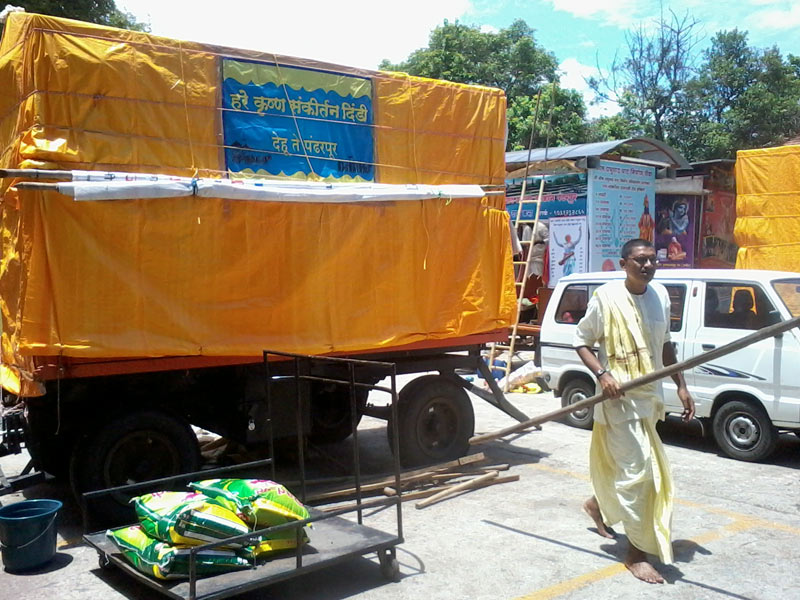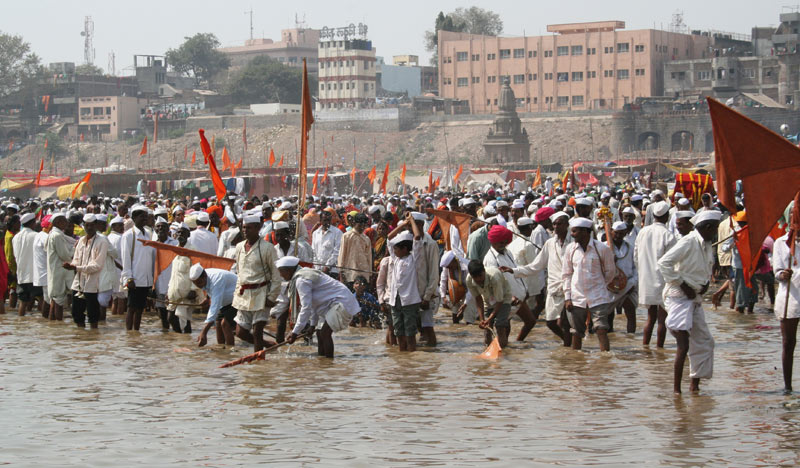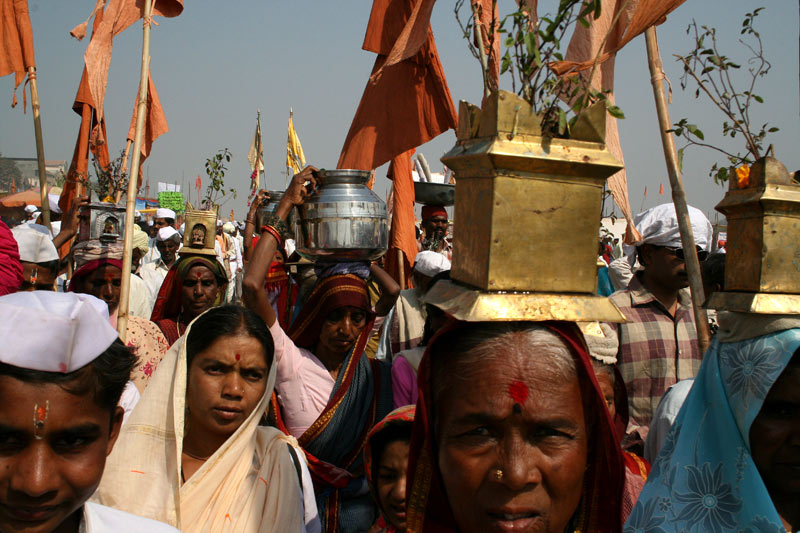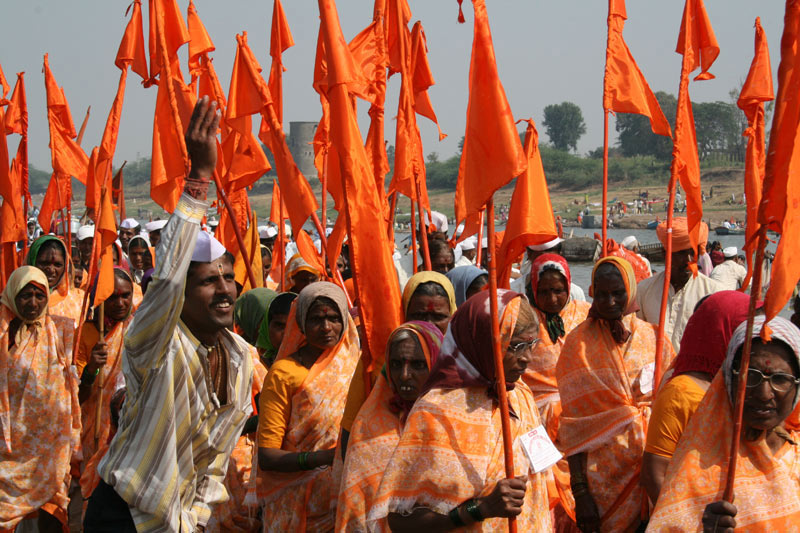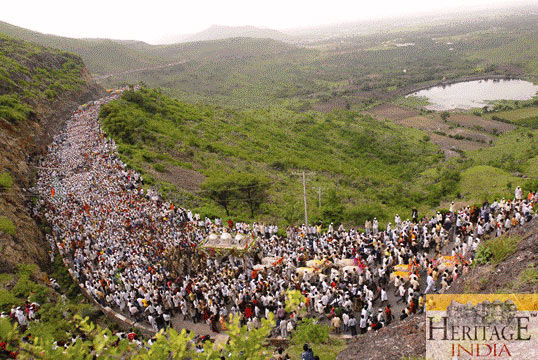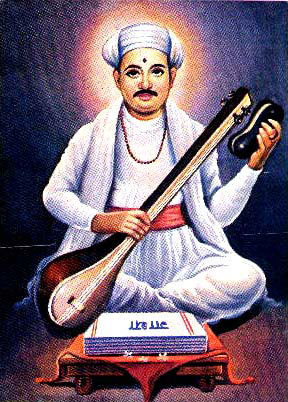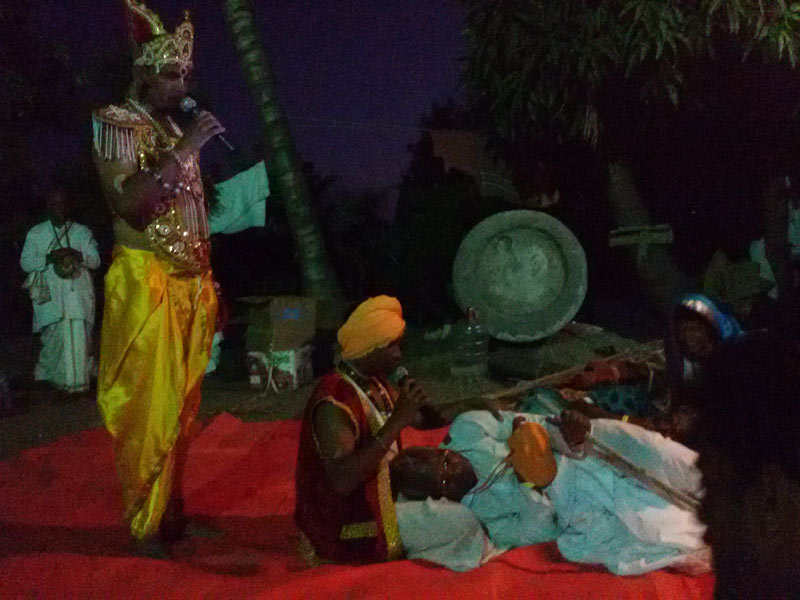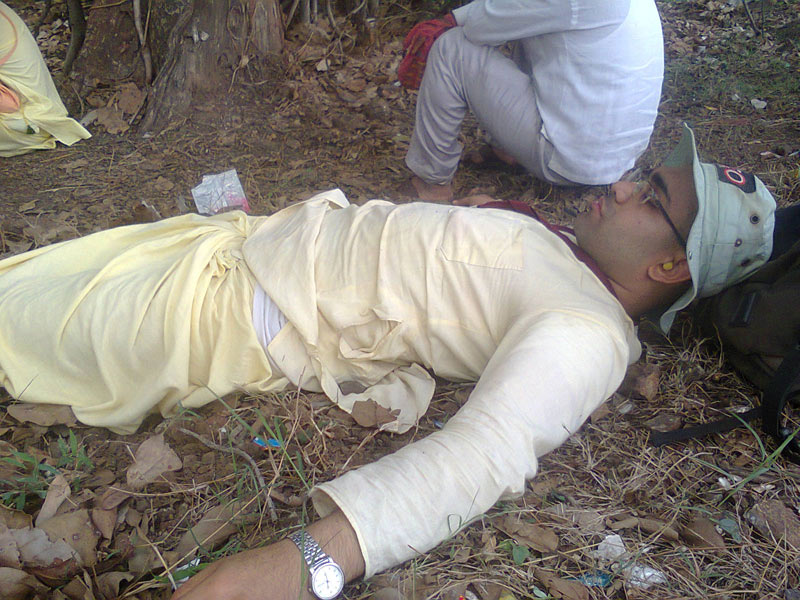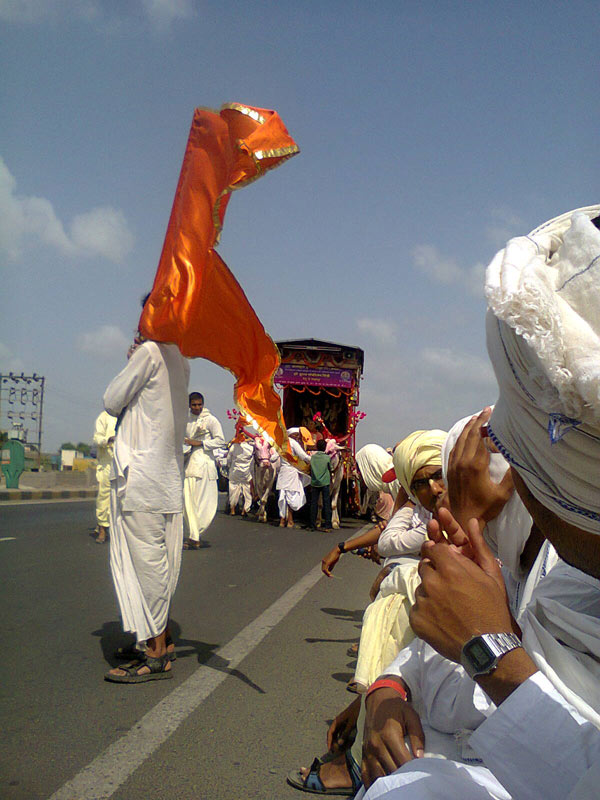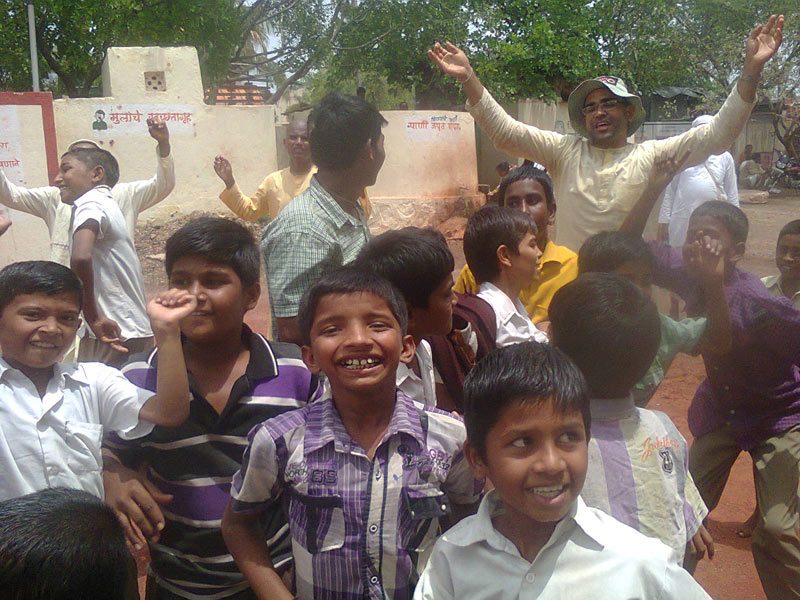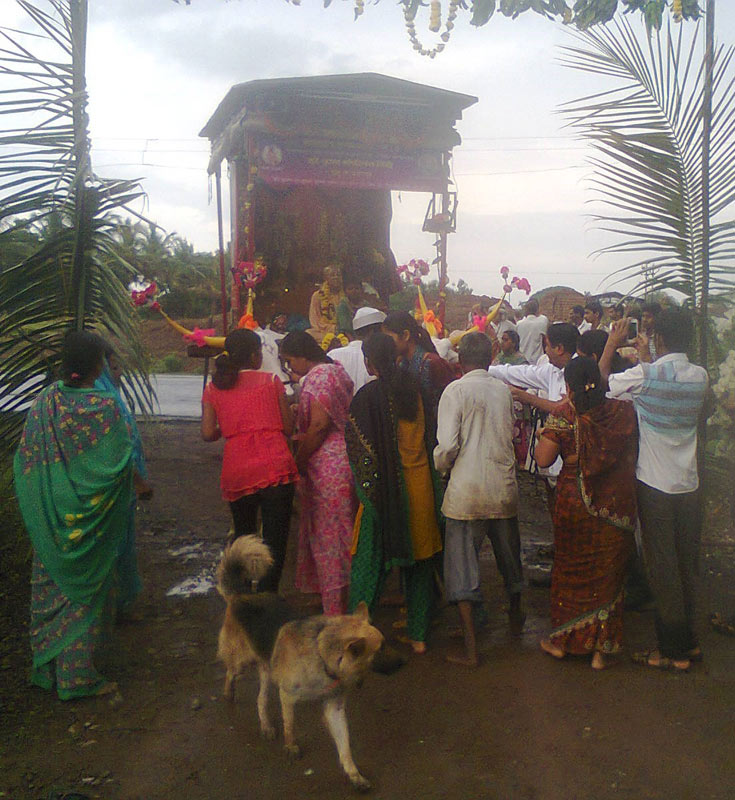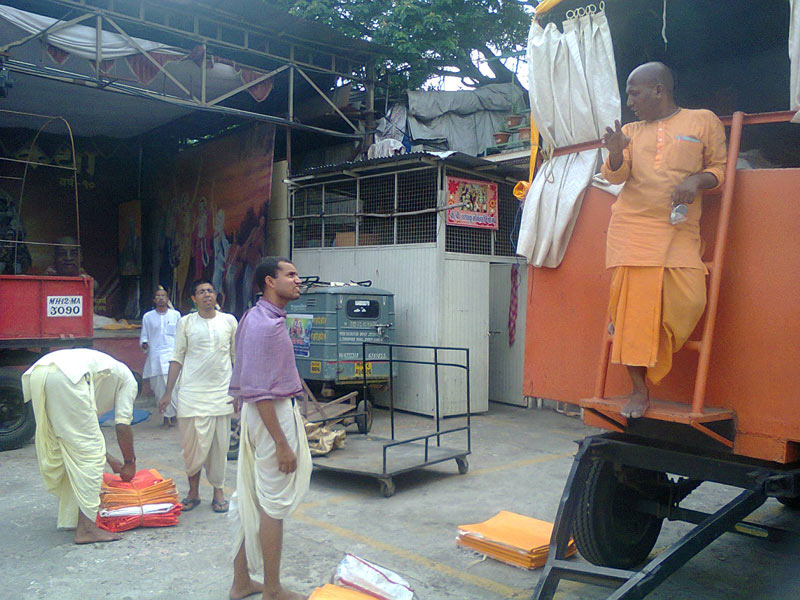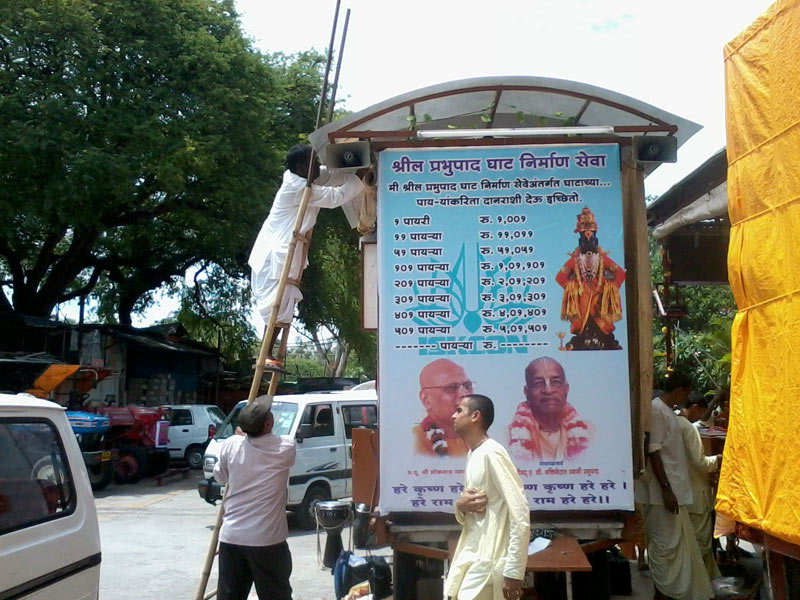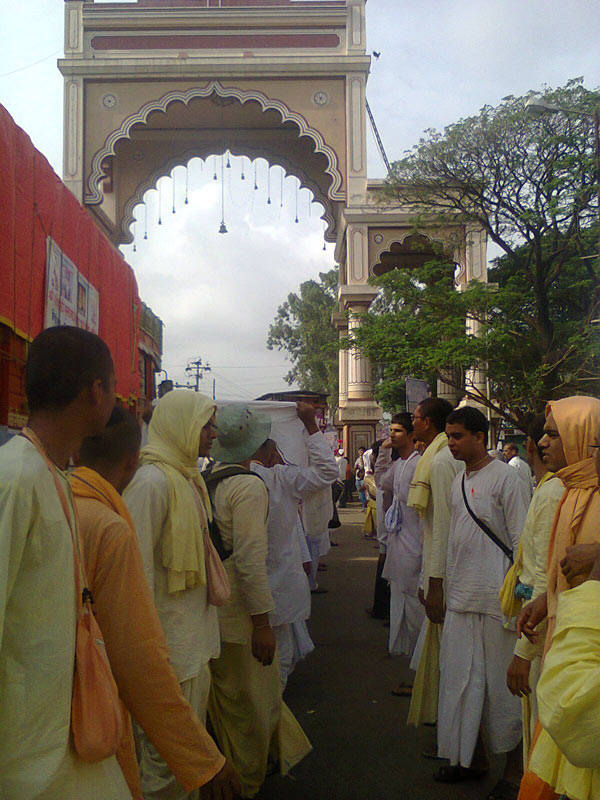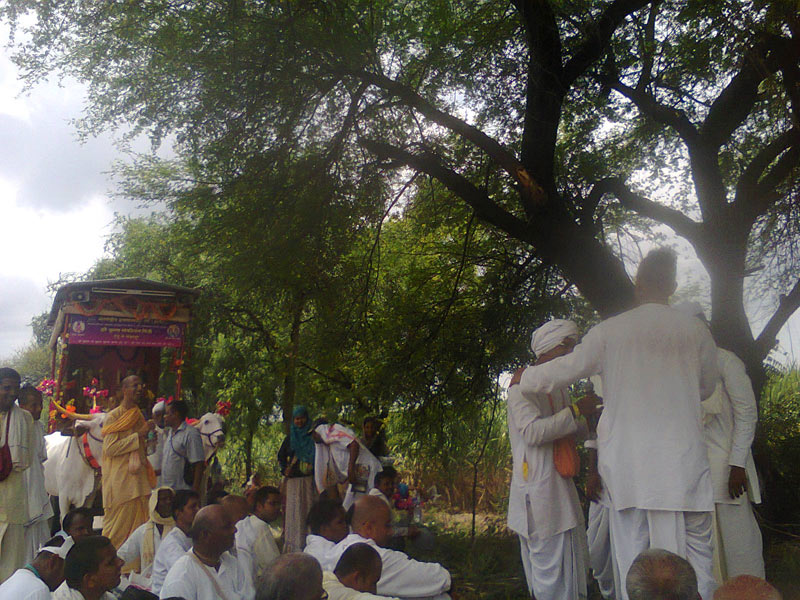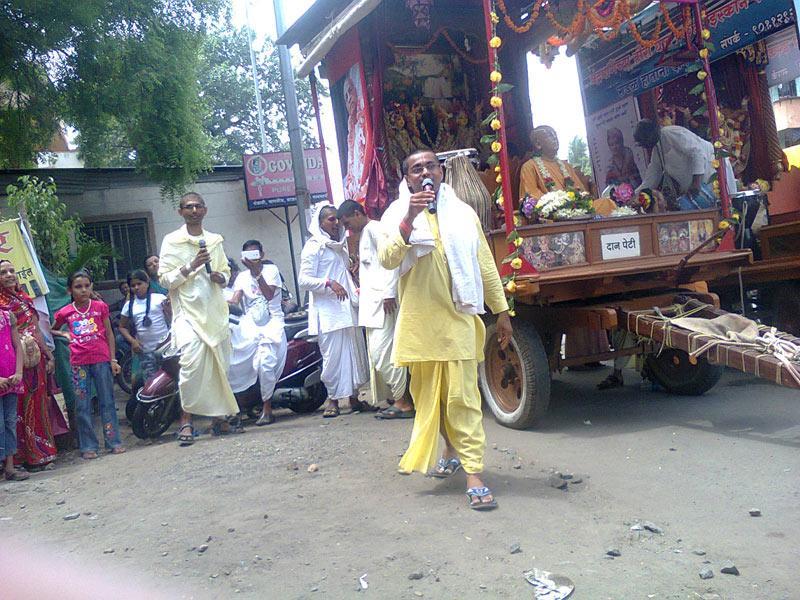Walking along one million other pilgrims
The “vari” or “dindi” from Dehu to Pandharpur via Pune is hailed as the greatest walking festival celebrated by the devotees of Lord Krishna who appeared as Lord Vitthala in the holy dhama of Pandharpur in Maharashtra. The literal meaning of vari is “the undertaking of this annual pilgrimage to Pandharpur”. The devotees or varkaris are men and women, young and old from all walks of life, age and socio-economic status. They walk alongside each other, never for even a moment being aware of their differences or status. They are all united in their faith in Lord Vitthala, who awaits this meeting with over one million of His devotees walking from Maharashtra and north Karnataka while constantly chanting the mantra ‘Jaya Jaya Rama Krishna Hari, Jaya Jaya Rama Krishna Hari.”
Dramatic singing and dancing from all the varkaris, men and women alike
The principle of simple living and being fully dependent on God is visibly conspicuous during the entire vari walk. Most of the pilgrims carry only as much luggage as can be fitted into a small handbag. They either cook in open fields along the way or eat whatever is arranged by the hosts in the town of their next destination. At night they sleep wherever a place is available – be it in schools or on the open grounds. Many ladies carry a tulasi plant on their heads while walking. Undaunted by the scorching heat of the sun or even occasional rains, they persevere and cover 10-15 kilometers everyday. The varkaris cheerful spirits are not dampened by the austerities of the walk. They are constantly singing traditional bhajans in their local languages, mostly Marathi, and chanting the holy names of Krishna while playing various instruments. The men in the vari sing so expertly in Indian classical music tunes that I couldn’t believe these simple village men possessed such prolific talents, and yet they would use it only for the glorification of God. Accompanying this musical feat, there are daily discourses on Bhagavat Dharma and very dramatic dancing, with the men gyrating, forming circles while holding hands , making rows and running between them rows, all this accompanied with facial gestures which I am not able to describe.The ladies’ dancing was also extremely active and energetic. Many people say that the ladies are kept in bondage and are not given sufficient chances to progress in Vedic culture, but after seeing their dancing I realized that these ladies were freer and happier in expressing the emotions of their ecstatic inner heart than their so called advanced city counterparts.
Joyful receptions for the pilgrims
This year marked the 18th anniversary of ISKCON Pune’s participation in this walking pilgrimage. On 19th June 2014, 140 devotees from ISKCON Pune started from Dehu, birthplace of one of the greatest saints of Maharashtra, ‘Sant (Saint) Tukaram’. The participants consisted of around 70 matajis lead by Satyavati Devi Dasi, 21 young brahmacaris from ISKCON Pune’s devoteet training program, some senior brahmacaris, and men from the Pune congregation. A few devotees from other temples also participated. The padayatra was presided over by the beautiful Deities of their Lordships Gaur Nitai riding majestically on the bullock cart. The procession lasted for 18 days with a one full day stop to rest. The walk through villages, cities, mountains, plain terrains and along the fields exposed the varkaris to a variety of different experiences. Our ISKCON procession was like a boat travelling in the vast sea of other pilgrims. Everywhere devotees were welcomed with colourful rangolis, flags, festoons and a display of massive hoardings on the important squares of the city put by local municipal corporations or politician, and shop owners. Hoardings are some kinds of panels made up of flex boards (plastic), generally the size of a big rectangle. They portray pictures of Lord Vitthala, great Maharashtrian saints such as Tukarama or Dnyaneshwar or contain welcome messages for the pilgrims. The varkaris were received with great joy and given fruits, water, and prasada along the way.
Life at the ISKCON camp
The enthusiastic and experienced padayatri, Laxmi Narayana Prabhu, led the whole team. He has the valuable experience of leading a bus book distribution party for many years, and originally comes from a village. All these assets made him the suitable person to lead the party, which he has been doing for many years. The devotees embraced the austerity of getting up very early in the morning and taking cold water baths in open areas. The day would commence at 4:30 am with the japa session, followed by mangal-arati and the Srimad Bhagavatam class. Laxmi Narayan Prabhu inspired and stimulated the devotees in the morning Bhagavatam classes with the teachings of Prahalada Maharaja. He would tell them that just as Prahlada Maharaja never asked the Lord for any protection but was given it, similarly all the varkaris walk without much arrangement and Lord Vitthala takes care of them. The devotees started walking around 8:30 am. The melodious kirtanas along the walk and the graceful dancing of devotees attracted onlookers wherever the procession went. After Gaura arati he would give classes for the brahmacaris based on his personal experience and realisations as a long standing brahmacari in ISKCON. He was assisted by Parthasarathi Prabhu, who took care of the other management details. Sripad Seva Prabhu and Sachinandan Vigrah Prabhu never disappointed the devotees with their expert cooking skills. Needless to say it was a challenging task to cook wholesome meals daily for over a hundred devotees. It is their dedication and desire to serve that makes it possible year after year. Many villagers freely donated vegetables and milk for our prasada. Such generosity as well as having a truck carrying all the kitchen utensils such as a stove, gas cylinders, and cooking ingredients made it possible to prepare breakfast items like poha (chipped rice), upma, idli etc. Lunch would include sabji (vegetables), chapati (flat bread), rice, dhal and a sweet.
Enthralling the cowds with their devotional dramas
Devotees performed short street dramas along the way based on different stories such as the sparrow’s determination to retrieve her eggs from the ocean and Garuda’s help, excerpts from Bhagavad Gita, the three types of austerities – Hiranyakashyapu’s in ignorance, Dhruva’s in passion, and Srila Prabhupada’s in transcendental goodness. The Indian BTG had published a special BTG magazine dedicated to this pilgrimage, and devotees distributed 13,400 copies of it. Along with that, we distributed 300 copies of Bhagavad Gita and hundreds of other books, such as Lokanath Swami Maharaja’s books on Lord Vitthala and Pandharpur dhama.
At the final destination of the day dramas on stories like Kailash, the brahmana and the cobbler, the life of Saint Purandar Das (a great devotee of Lord Vitthala), the story of the prodigal son, the story of Ambarish and Durvasa muni which tells us of the dangers of offending vaisnavas, the boatman and the scientist story, the Kazi and Lord Caitanya story, and many more were enacted. These dramas completely enthralled the audience. At night, devotees would generally stay and rest at local schools or sometimes in the houses of families in villages who generously opened their homes. It was in this manner that the entire distance of more than 200 kilometres was covered and the padayatra devotees reached their final destination, Sri Pandharpur Dham. There they were happily received by the ISKCON Pandharpur temple devotees. The pinnacle of the padayatra was the special interactive session with Lokanath Swami Maharaja. Maharaja distributed prasada and gifts, acknowledged and thanked the participants for their various services, spoke encouraging words and shared valuable realisations.
Doctor Vishal Oza: The continuous chanting of the holy names and the simple life of the vari padayatra has truly inspired my spiritual life. I was specifically affected by observing the simple and austere life of the other varkaris. I offered medical assistance to the devotees. Along the way, one of the carts passed over the hand of an old lady and cut her hand deeply. She needed stitches. I applied the dressing onto her injured hand. Throughout this ordeal she never complained about anybody and she was perfectly calm. This incident and many similar experiences touched my heart and I look forward to joining the pilgrimage again in the future.

